Hue Angle-Based Remote Sensing of Secchi Disk Depth Using Sentinel-3 OLCI in the Coastal Waters of Qinhuangdao, China
Abstract
1. Introduction
2. Materials and Methods
2.1. Research Area
2.2. Data Sources
2.2.1. In Situ Measured Data
2.2.2. Satellite Data
2.3. Derivation of Hue Angle
2.4. Evaluation Method
3. Results
3.1. Development of the Retrieval Model for the Study Area
3.2. Spatiotemporal Variation of SDD
3.2.1. Monthly Spatiotemporal Variation
3.2.2. Interannual Spatiotemporal Variation
4. Discussion
4.1. Correlation Analysis Between SDD and Water-Color Constituents
4.2. Analysis of the Influencing Factors of the Spatiotemporal Variation of SDD
5. Conclusions
Author Contributions
Funding
Data Availability Statement
Conflicts of Interest
References
- Zhou, Y.; Yu, D.F.; Yang, Q.; Pan, S.Q.; Gai, Y.Y.; Cheng, W.T.; Liu, X.Y.; Tang, S.L. Variations of water transparency and impact factors in the Bohai and Yellow Seas from satellite observations. Remote Sens. 2021, 13, 514. [Google Scholar] [CrossRef]
- Guo, J.T.; Pan, H.D.; Cao, R.C.; Wang, J.F.; Lv, X.Q. Multiple timescale variations in water transparency in the Eastern China Sea over the period 1997–2019. J. Geophys. Res. Oceans. 2023, 128, e2022JC019170. [Google Scholar] [CrossRef]
- Sun, Y.; Xu, Y.X.; Liu, D.Z.; Xu, G.J. Analysis of environmental factors impact on water transparency off southeastern Vietnam. Front. Mar. Sci. 2023, 10, 1095663. [Google Scholar] [CrossRef]
- Kahru, M.; Lee, Z.P.; Ohman, M.D. Multidecadal changes in ocean transparency: Decrease in a coastal upwelling region and increase offshore. Limnol. Oceanogr. 2023, 68, 1546–1556. [Google Scholar] [CrossRef]
- Kirby, R.R.; Beaugrand, G.; Kleparski, L.; Goodall, S.; Lavender, S. Citizens and scientists collect comparable oceanographic data: Measurements of ocean transparency from the Secchi Disk study and science programmes. Sci. Rep. 2021, 11, 15499. [Google Scholar] [CrossRef]
- Waya, R.K.; Limbu, S.M.; Ngupula, G.W.; Mwita, C.J.; Mgaya, Y.D. Spatial patterns of zooplankton distribution and abundance in relation to phytoplankton, fish catch and some water quality parameters at Shirati Bay, Lake Victoria-Tanzania. Tanzan. J. Sci. 2014, 40, 20–32. [Google Scholar]
- Wernand, M.R.; van der Woerd, H.J. Spectral analysis of the Forel-Ule Ocean color comparator scale. J. Eur. Opt. Soc. Rapid Publ. 2010, 5, 10014s. [Google Scholar] [CrossRef]
- Tyler, J.E. The Secchi disc. Limnol. Oceanogr. 1968, 13, 1–6. [Google Scholar] [CrossRef]
- Jiang, L.L.; Wang, L.X.; Wang, L.; Gao, S.W.; Yue, J.Q. Research on remote sensing retrieval of Bohai Sea transparency based on Sentinel-3 OLCI image. Spectrosc. Spectr. Anal. 2022, 42, 1209–1216. [Google Scholar] [CrossRef]
- He, S.L.; Chen, X.; Li, S.; Yao, X.L.; Xu, Z.P. Small hyperspectral imagers and lidars and their marine applications. Infrared Laser Eng. 2020, 49, 202002003. [Google Scholar] [CrossRef]
- Doron, M.; Babin, M.; Hembise, O.; Mangin, A.; Garnesson, P. Ocean transparency from space: Validation of algorithms estimating Secchi depth using MERIS, MODIS and SeaWiFS data. Remote Sens. Environ. 2011, 115, 2986–3001. [Google Scholar] [CrossRef]
- Page, B.P.; Olmanson, L.G.; Mishra, D.R. A harmonized image processing workflow using Sentinel-2/MSI and Landsat-8/OLI for mapping water clarity in optically variable lake systems. Remote Sens. Environ. 2019, 231, 111284. [Google Scholar] [CrossRef]
- Wang, Q.; Song, K.S.; Xiao, X.M.; Jacinthe, P.A.; Wen, Z.D.; Zhao, F.R.; Tao, H.; Li, S.J.; Shang, Y.X.; Wang, Y.; et al. Mapping water clarity in North American lakes and reservoirs using Landsat images on the GEE platform with the RGRB model. ISPRS J. Photogramm. Remote Sens. 2022, 194, 39–57. [Google Scholar] [CrossRef]
- Lee, Z.P.; Shang, S.L.; Qi, L.; Yan, J.; Lin, G. A semi-analytical scheme to estimate Secchi-disk depth from Landsat-8 measurements. Remote Sens. Environ. 2016, 177, 101–106. [Google Scholar] [CrossRef]
- Jia, T.X.; Zhang, Y.L.; Weng, C.; Dong, R.C. Improving remote sensing retrieval of global ocean transparency with optical water classification. Ecol. Indic. 2022, 143, 109359. [Google Scholar] [CrossRef]
- Xiang, J.Z.; Cui, T.W.; Qing, S.; Liu, R.J.; Chen, Y.L.; Mu, B.; Zhang, X.B.; Zhao, W.J.; Ma, Y.; Zhang, J. Remote sensing retrieval of water clarity in clear oceanic to extremely turbid coastal waters from multiple spaceborne sensors. IEEE Trans. Geosci. Remote Sens. 2023, 61, 4207618. [Google Scholar] [CrossRef]
- Wang, Q.; Liu, G.; Song, K.S.; Wen, Z.D.; Shang, Y.X.; Li, S.J.; Fang, C.; Tao, H. Comparison of machine learning algorithms for estimating global lake clarity with Landsat TOA data. IEEE Trans. Geosci. Remote Sens. 2024, 62, 1–14. [Google Scholar] [CrossRef]
- Salas, J.; Sepúlveda, R.; Vera, P. Water clarity assessment through satellite imagery and machine learning. Water 2025, 17, 253. [Google Scholar] [CrossRef]
- Synan, H.E.; Howes, B.L.; Sampieri, S.; Lohrenz, S.E. Water quality monitoring using Landsat 8 OLI in Pleasant Bay, Massachusetts, USA. Remote Sens. 2025, 17, 638. [Google Scholar] [CrossRef]
- Garaba, S.P.; Badewien, T.H.; Braun, A.; Schulz, A.C.; Zielinski, O. Using ocean colour remote sensing products to estimate turbidity at the Wadden Sea time series station Spiekeroog. J. Eur. Opt. Soc. Rapid Publ. 2014, 9, 14020. [Google Scholar] [CrossRef]
- Garaba, S.P.; Friedrichs, A.; Voß, D.; Zielinski, O. Classifying natural waters with the Forel-Ule color index system: Results, applications, correlations and crowdsourcing. Int. J. Environ. Res. Public Health 2015, 12, 16096–16109. [Google Scholar] [CrossRef] [PubMed]
- Wernand, M.R.; van der Woerd, H.J.; Gieskes, W.W.C. Trends in ocean colour and chlorophyll concentration from 1889 to 2000, worldwide. PLoS ONE 2013, 8, e63766. [Google Scholar] [CrossRef] [PubMed]
- Wang, L.; Wang, X.; Meng, Q.H.; Chen, Y.L.; Wang, X.X.; Jiang, L.L.; Shang, Y.H. Retrieval and spatiotemporal variation of total suspended matter concentration using a MODIS-derived hue angle in the coastal waters of Qinhuangdao, China. Front. Mar. Sci. 2024, 11, 1434225. [Google Scholar] [CrossRef]
- Wang, S.L.; Li, J.S.; Shen, Q.; Zhang, B.; Zhang, F.F.; Lu, Z.Y. MODIS-based radiometric color extraction and classification of inland water with the Forel-Ule scale: A case study of Lake Taihu. IEEE J. Sel. Top. Appl. Earth Obs. Remote Sens. 2014, 8, 907–918. [Google Scholar] [CrossRef]
- Pitarch, J.; van der Woerd, H.J.; Brewin, R.J.W.; Zielinski, O. Optical properties of Forel-Ule water types deduced from 15 years of global satellite ocean color observations. Remote Sens. Environ. 2019, 231, 111249. [Google Scholar] [CrossRef]
- Zhan, J.; Zhang, D.J.; Zhou, G.Q.; Zhang, G.Y.; Cao, L.J.; Guo, Q. MODIS-based research on Secchi disk depth using an improved semianalytical algorithm in the Yellow Sea. IEEE J. Sel. Top. Appl. Earth Obs. Remote Sens. 2021, 14, 5964–5972. [Google Scholar] [CrossRef]
- Wang, S.L.; Li, J.S.; Zhang, B.; Spyrakos, E.; Tyler, A.N.; Shen, Q.; Zhang, F.F.; Kuster, T.; Lehmann, M.K.; Wu, Y.H.; et al. Trophic state assessment of global inland waters using a MODIS-derived Forel-Ule index. Remote Sens. Environ. 2018, 217, 444–460. [Google Scholar] [CrossRef]
- Chen, Q.; Huang, M.T.; Tang, X.D. Eutrophication assessment of seasonal urban lakes in China Yangtze River Basin using Landsat 8-derived Forel-Ule index: A six-year (2013–2018) observation. Sci. Total Environ. 2020, 745, 135392. [Google Scholar] [CrossRef] [PubMed]
- Liu, R.J.; Xiao, Y.F.; Ma, Y.; Cui, T.W.; An, J.B. Red tide detection based on high spatial resolution broad band optical satellite data. ISPRS J. Photogramm. Remote Sens. 2022, 184, 131–147. [Google Scholar] [CrossRef]
- Hou, X.J.; Feng, L.; Dai, Y.H.; Hu, C.M.; Gibson, L.; Tang, J.; Lee, Z.P.; Wang, Y.; Cai, X.B.; Liu, J.G.; et al. Global mapping reveals increase in lacustrine algal blooms over the past decade. Nat. Geosci. 2022, 15, 130–134. [Google Scholar] [CrossRef]
- Dai, Y.H.; Yang, S.B.; Zhao, D.; Hu, C.M.; Xu, W.; Anderson, D.M.; Li, Y.; Song, X.P.; Boyce, D.G.; Gibson, L.; et al. Coastal phytoplankton blooms expand and intensify in the 21st century. Nature 2023, 615, 280–284. [Google Scholar] [CrossRef] [PubMed]
- Wang, L.; Meng, Q.H.; Wang, X.; Chen, Y.L.; Wang, X.X.; Han, J.; Wang, B.Q. Identification of floating green tide in high-turbidity water from Sentinel-2 MSI images employing NDVI and CIE hue angle thresholds. J. Mar. Sci. Eng. 2024, 12, 1640. [Google Scholar] [CrossRef]
- Shang, Y.H.; Jiang, L.L.; Wang, L.; Ye, Z.X.; Gao, S.W.; Tang, X.H. Methods for detecting green tide in the Yellow Sea using Google Earth Engine platform. Reg. Stud. Mar. Sci. 2024, 77, 103666. [Google Scholar] [CrossRef]
- Ma, B.C.; Sun, D.Y.; Li, Z.H.; Kong, D.Y.; Pan, X.S.; Wang, S.Q.; Zhang, H.L.; He, Y.J. Marine water quality environmental monitoring method based on hue-angle in CIE system. Adv. Mar. Sci. 2023, 41, 135–147. [Google Scholar]
- Bukata, R.P.; Pozdnyakov, D.V.; Jerome, J.H.; Tanis, F.J. Validation of a radiometric color model applicable to optically complex water bodies. Remote Sens. Environ. 2001, 77, 165–172. [Google Scholar] [CrossRef]
- van der Woerd, H.J.; Wernand, M.R. True colour classification of natural waters with medium-spectral resolution satellites: SeaWiFS, MODIS, MERIS and OLCI. Sensors 2015, 15, 25663–25680. [Google Scholar] [CrossRef]
- van der Woerd, H.J.; Wernand, M.R. Hue-angle product for low to medium spatial resolution optical satellite sensors. Remote Sens. 2018, 10, 180. [Google Scholar] [CrossRef]
- Wang, S.L. Large-Scale and Long-Time Water Quality Remote Sensing Monitoring over Lakes Based on Water Color Index. Ph.D. Thesis, University of Chinese Academy of Sciences, Beijing, China, 2018. [Google Scholar]
- Wang, L.; Meng, Q.H.; Wang, X.; Chen, Y.L.; Zhao, S.F.; Wang, X.X. Forel-Ule index extraction and spatiotemporal variation from MODIS imagery in the Bohai Sea of China. Opt. Express 2023, 31, 17861–17877. [Google Scholar] [CrossRef]
- Global Modeling and Assimilation Office (GMAO). MERRA-2 tavgU_2d_flx_Nx: 2d, Diurnal, Time-Averaged, Single-Level, Assimilation, Surface Flux Diagnostics V5.12.4; Goddard Earth Sciences Data and Information Services Center (GES DISC): Greenbelt, MD, USA, 2015. [CrossRef]
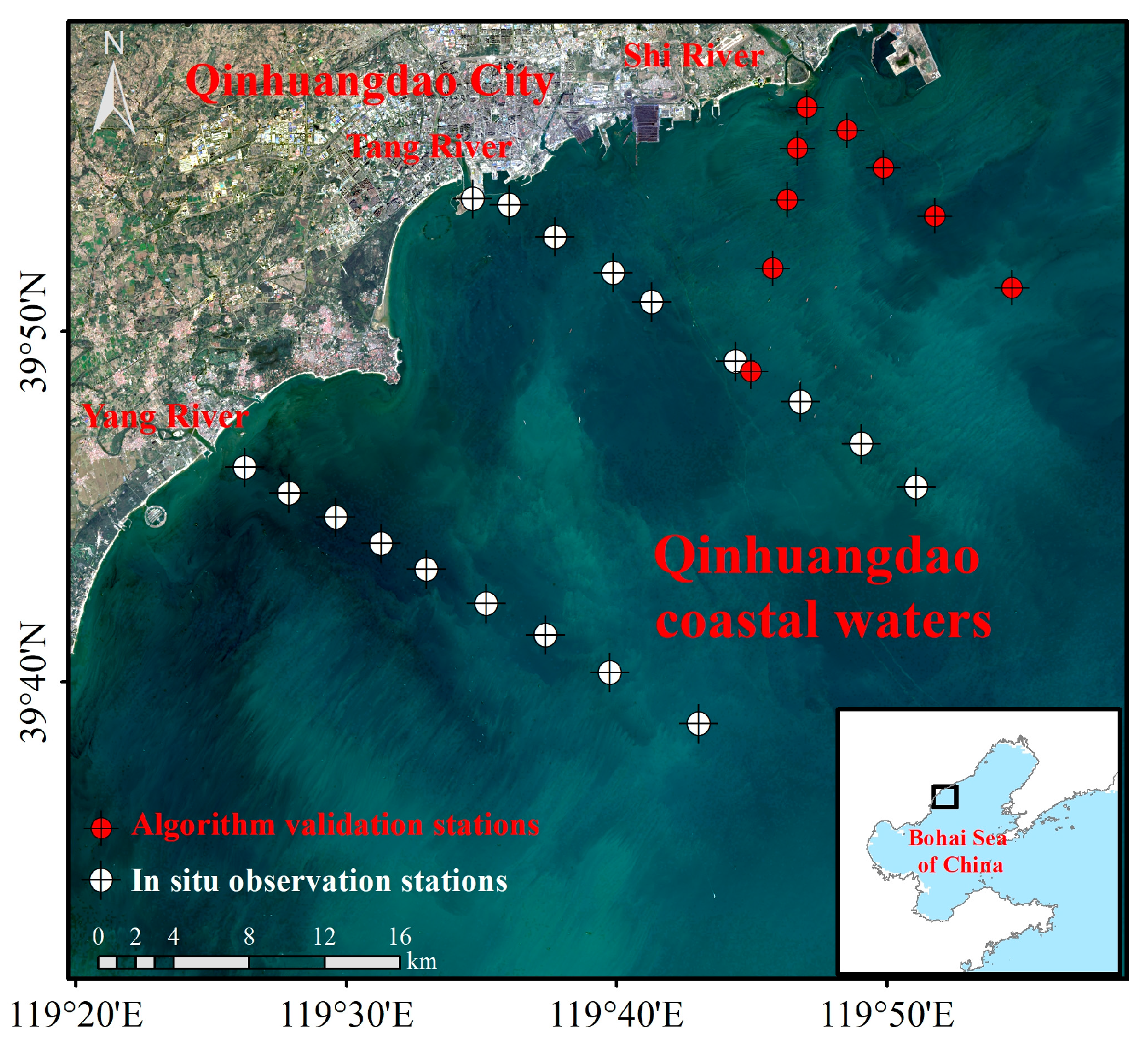

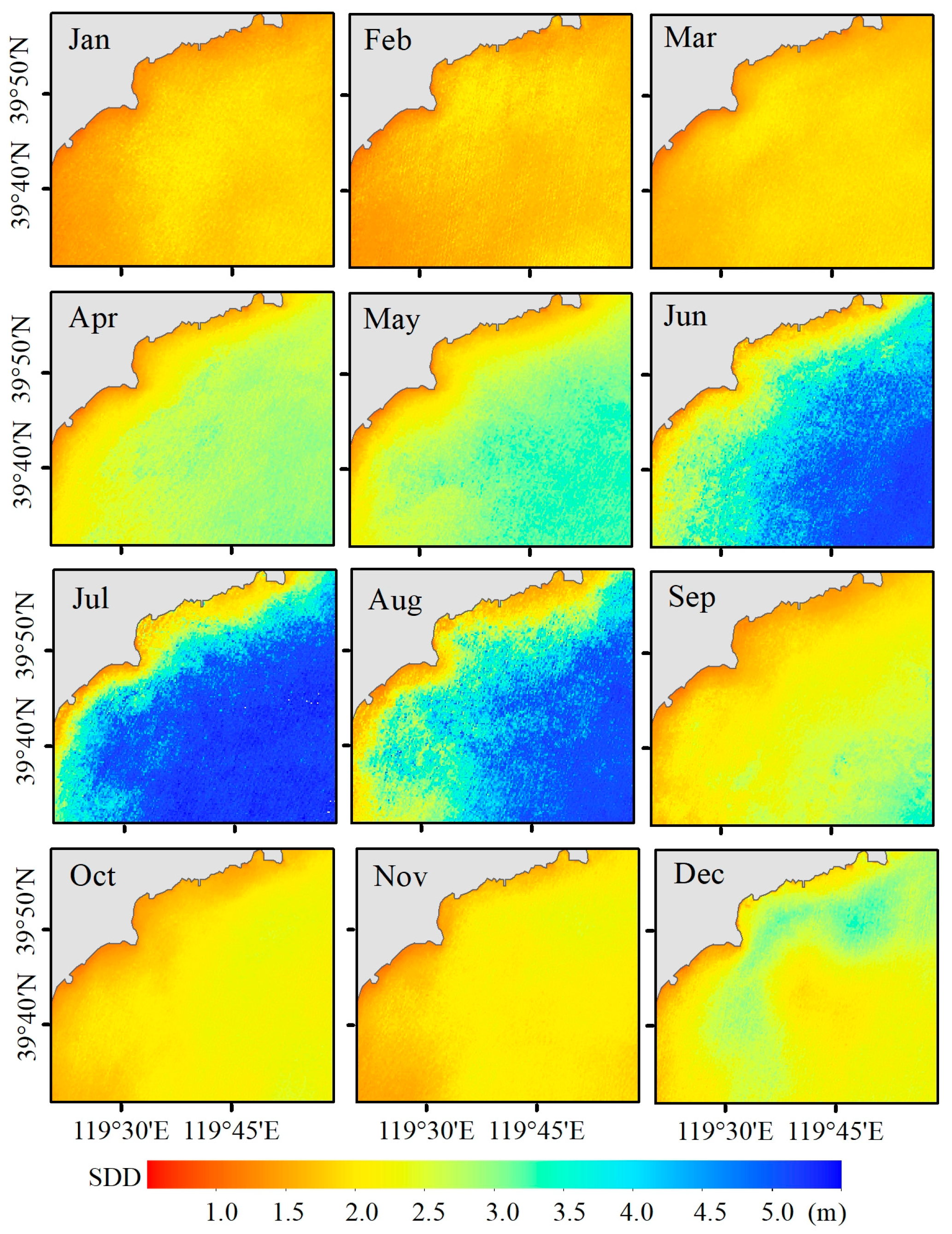

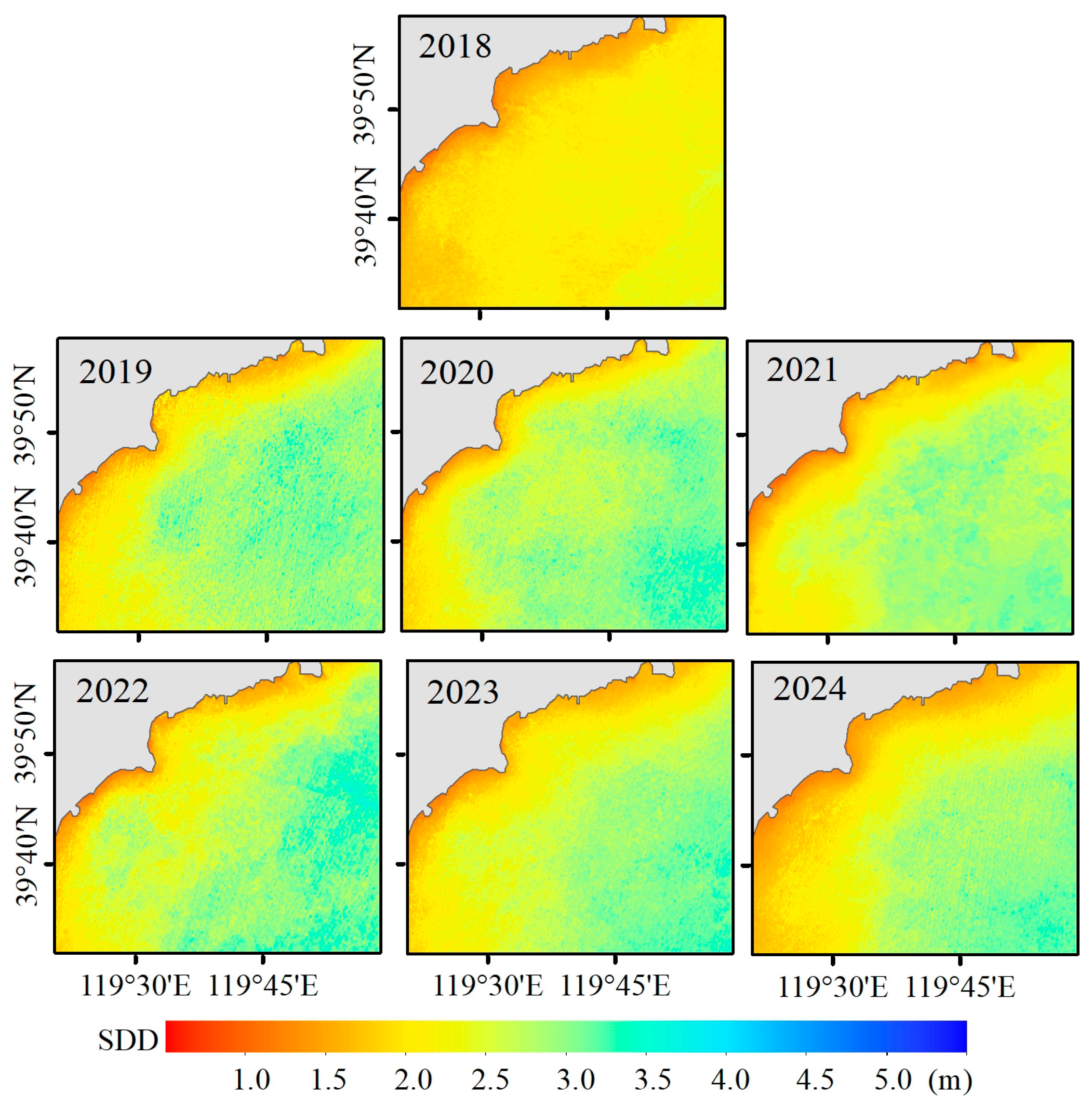

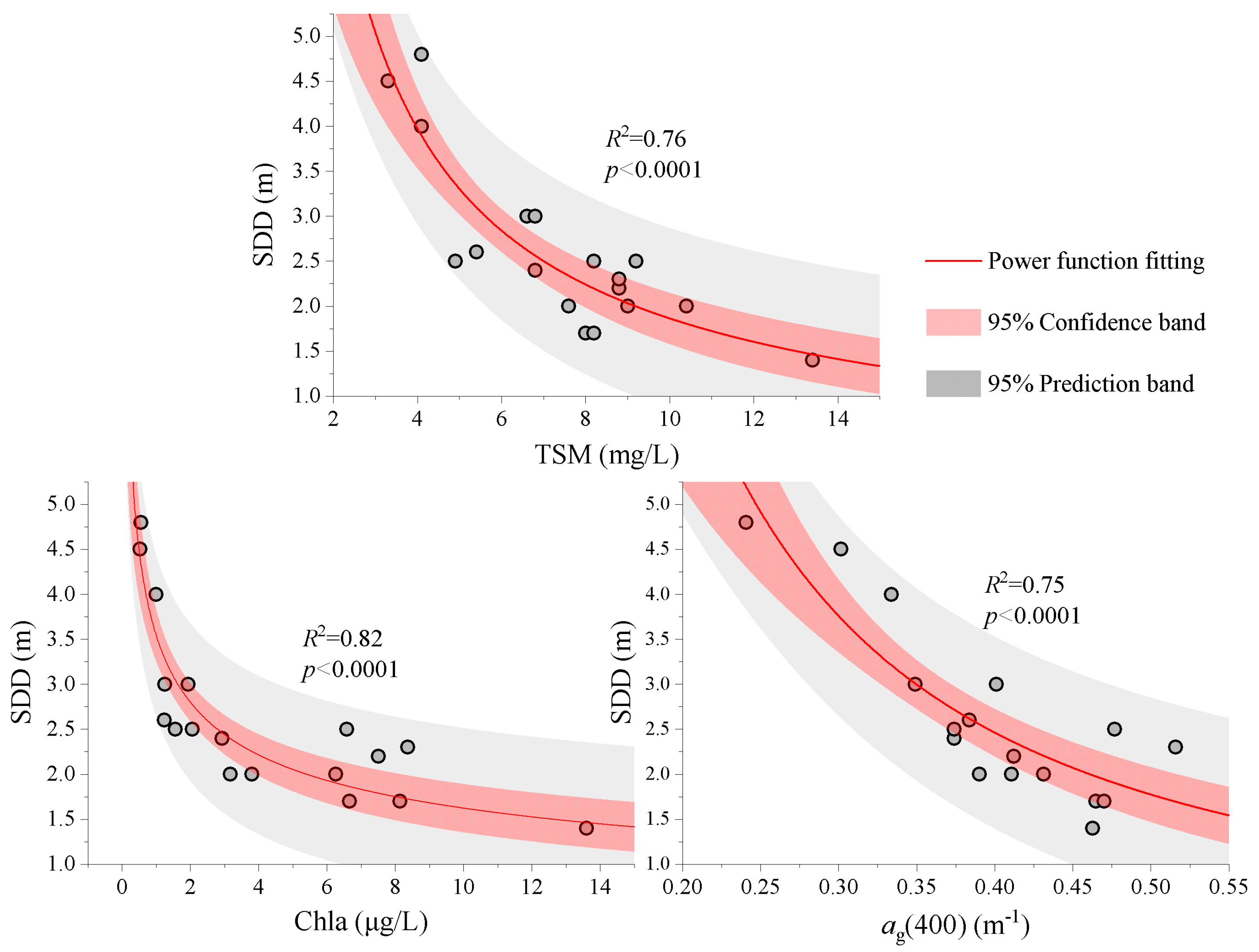
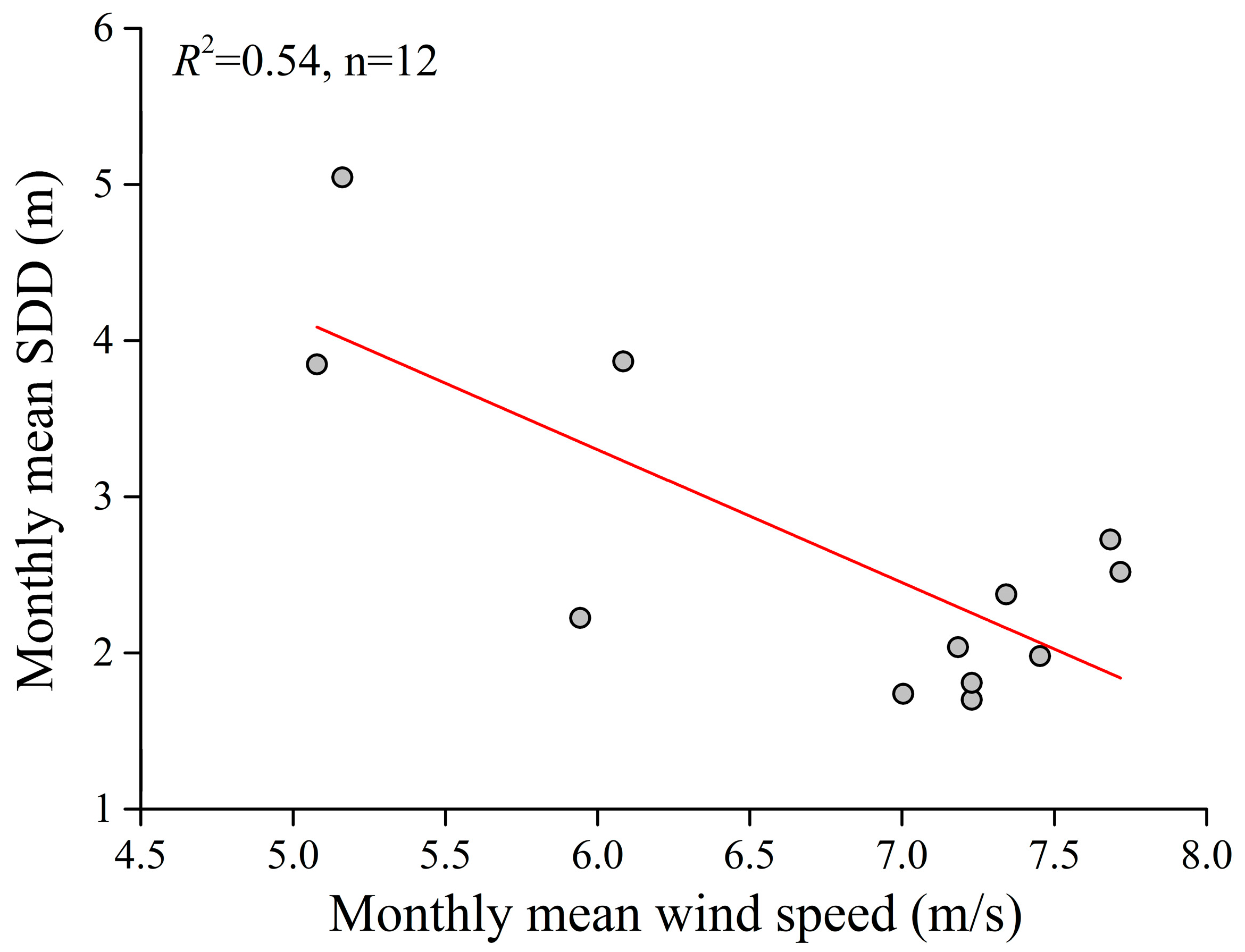
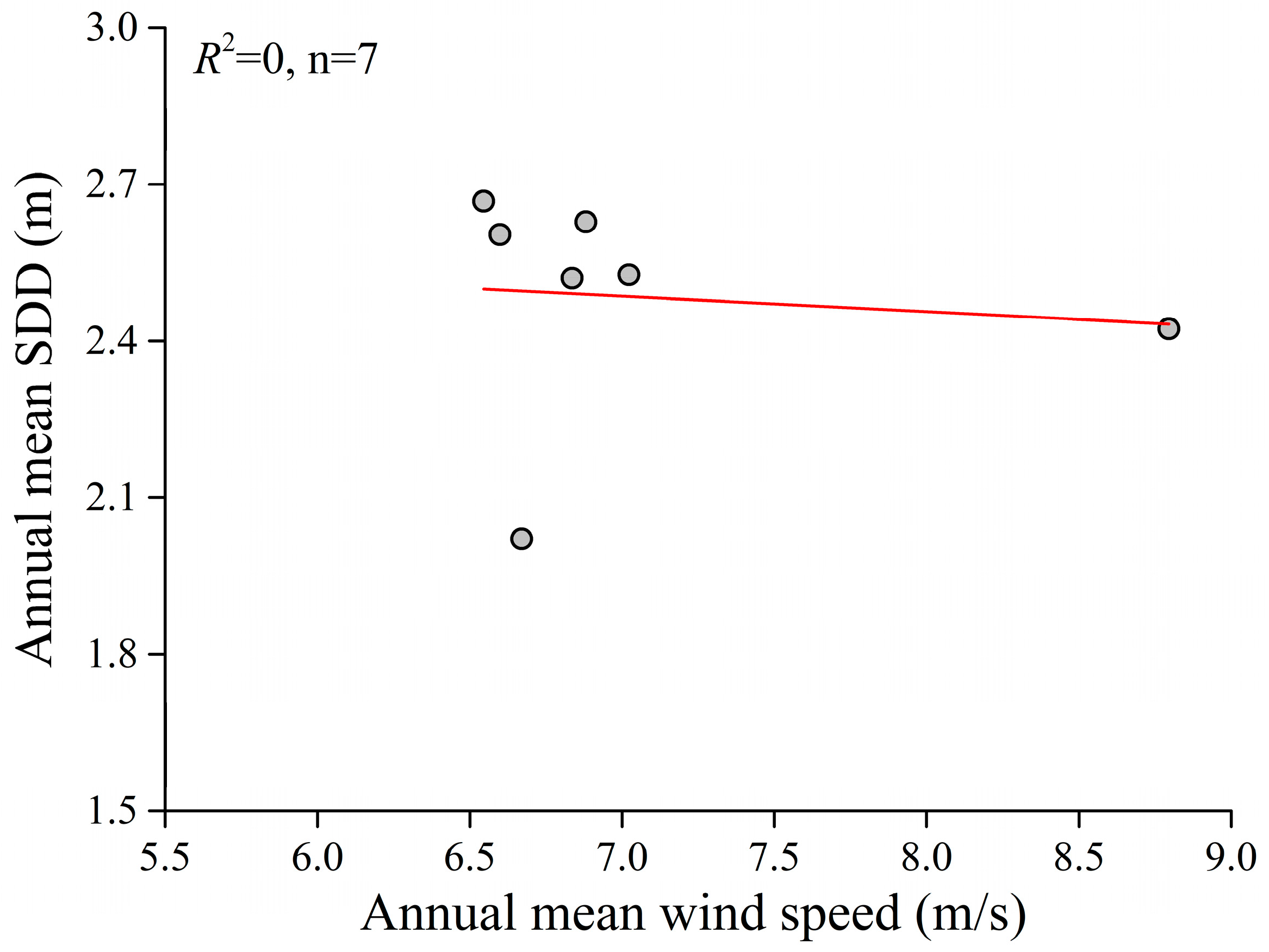
| Number | Algorithm Type | Algorithm Expression | R2 | MAPE (%) | RMSE (m) |
|---|---|---|---|---|---|
| A1 | Single-band | SDD = 0.0634 × Rrs(620)−0.552 | 0.69 | 15.36 | 0.53 |
| A2 | SDD = 0.0478 × Rrs(665)−0.563 | 0.71 | 15.05 | 0.51 | |
| A3 | SDD = 0.0332 × Rrs(673.75)−0.624 | 0.81 | 12.04 | 0.41 | |
| A4 | SDD = 0.0404 × Rrs(681.25)−0.602 | 0.84 | 11.00 | 0.38 | |
| A5 | SDD = 0.1261 × Rrs(708.75)−0.38 | 0.69 | 14.50 | 0.52 | |
| A6 | Band-ratio | SDD = 1.1763 × e2.4777×(Rrs(412.5)/Rrs(560)) | 0.68 | 15.17 | 0.53 |
| A7 | SDD = 0.9155 × e2.5848×(Rrs(442.5)/Rrs(560)) | 0.79 | 12.11 | 0.43 | |
| A8 | SDD = 0.5505 × e2.2983×(Rrs(490)/Rrs(560)) | 0.90 | 8.75 | 0.29 | |
| A9 | SDD = 0.3305 × e2.6096×(Rrs(510)/Rrs(560)) | 0.91 | 8.44 | 0.28 | |
| A10 | SDD = 0.7425 × (Rrs(673.75)/Rrs(560))−0.861 | 0.69 | 16.57 | 0.52 | |
| A11 | SDD = 0.8055 × (Rrs(681.25)/Rrs(560))−0.848 | 0.76 | 14.55 | 0.45 | |
| A12 | Multi-band | SDD = 10−0.3378−0.5551×(Rrs(442.5)/Rrs(560))+1.4450×(Rrs(490)/Rrs(560)) | 0.90 | 8.60 | 0.28 |
| A13 | SDD = 10−0.5667−0.2837×(Rrs(442.5)/Rrs(560))+1.3862×(Rrs(510)/Rrs(560)) | 0.91 | 8.40 | 0.27 | |
| A14 | SDD = 10−0.5736−0.4414×(Rrs(490)/Rrs(560))+1.6278×(Rrs(510)/Rrs(560)) | 0.91 | 8.52 | 0.28 | |
| A15 | SDD = 10−0.5832+1.5717×(Rrs(442.5)/Rrs(560))−0.4049×(Rrs(490)/Rrs(560))+1.6006×(Rrs(510)/Rrs(560)) | 0.91 | 8.44 | 0.27 | |
| A16 | Hue angle | 47.576 × e−1.729×(α/100) | 0.93 | 7.88 | 0.25 |
| A17 | 11.02 × (α/100)−2.816 | 0.92 | 8.36 | 0.26 |
Disclaimer/Publisher’s Note: The statements, opinions and data contained in all publications are solely those of the individual author(s) and contributor(s) and not of MDPI and/or the editor(s). MDPI and/or the editor(s) disclaim responsibility for any injury to people or property resulting from any ideas, methods, instructions or products referred to in the content. |
© 2025 by the authors. Licensee MDPI, Basel, Switzerland. This article is an open access article distributed under the terms and conditions of the Creative Commons Attribution (CC BY) license (https://creativecommons.org/licenses/by/4.0/).
Share and Cite
Huo, Y.; Zhao, S.; Yuan, Z.; Wang, X.; Wang, L. Hue Angle-Based Remote Sensing of Secchi Disk Depth Using Sentinel-3 OLCI in the Coastal Waters of Qinhuangdao, China. J. Mar. Sci. Eng. 2025, 13, 1149. https://doi.org/10.3390/jmse13061149
Huo Y, Zhao S, Yuan Z, Wang X, Wang L. Hue Angle-Based Remote Sensing of Secchi Disk Depth Using Sentinel-3 OLCI in the Coastal Waters of Qinhuangdao, China. Journal of Marine Science and Engineering. 2025; 13(6):1149. https://doi.org/10.3390/jmse13061149
Chicago/Turabian StyleHuo, Yongwei, Sufang Zhao, Zhongjie Yuan, Xiang Wang, and Lin Wang. 2025. "Hue Angle-Based Remote Sensing of Secchi Disk Depth Using Sentinel-3 OLCI in the Coastal Waters of Qinhuangdao, China" Journal of Marine Science and Engineering 13, no. 6: 1149. https://doi.org/10.3390/jmse13061149
APA StyleHuo, Y., Zhao, S., Yuan, Z., Wang, X., & Wang, L. (2025). Hue Angle-Based Remote Sensing of Secchi Disk Depth Using Sentinel-3 OLCI in the Coastal Waters of Qinhuangdao, China. Journal of Marine Science and Engineering, 13(6), 1149. https://doi.org/10.3390/jmse13061149






